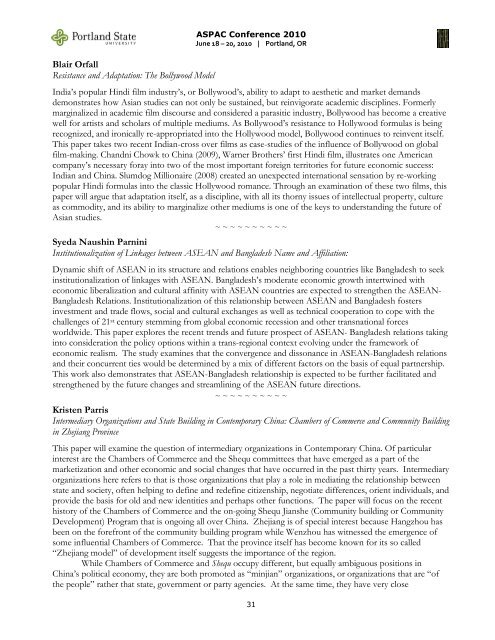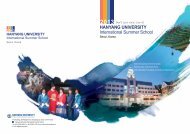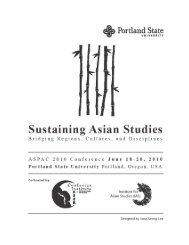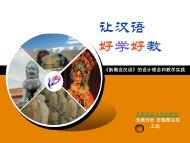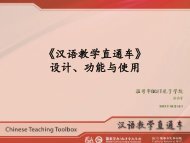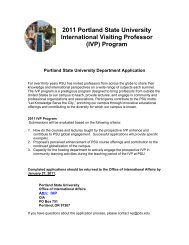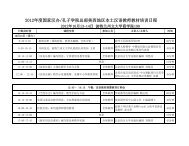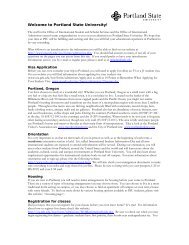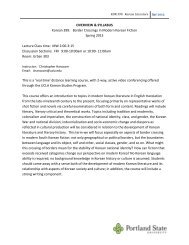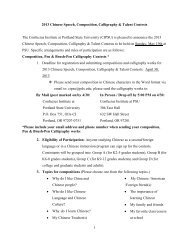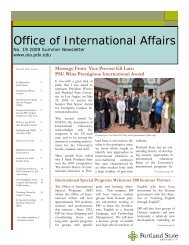ABSTRACTS - oia - Portland State University
ABSTRACTS - oia - Portland State University
ABSTRACTS - oia - Portland State University
Create successful ePaper yourself
Turn your PDF publications into a flip-book with our unique Google optimized e-Paper software.
Blair Orfall<br />
Resistance and Adaptation: The Bollywood Model<br />
ASPAC Conference 2010<br />
June 18 – 20, 2010 | <strong>Portland</strong>, OR<br />
India’s popular Hindi film industry’s, or Bollywood’s, ability to adapt to aesthetic and market demands<br />
demonstrates how Asian studies can not only be sustained, but reinvigorate academic disciplines. Formerly<br />
marginalized in academic film discourse and considered a parasitic industry, Bollywood has become a creative<br />
well for artists and scholars of multiple mediums. As Bollywood’s resistance to Hollywood formulas is being<br />
recognized, and ironically re-appropriated into the Hollywood model, Bollywood continues to reinvent itself.<br />
This paper takes two recent Indian-cross over films as case-studies of the influence of Bollywood on global<br />
film-making. Chandni Chowk to China (2009), Warner Brothers’ first Hindi film, illustrates one American<br />
company’s necessary foray into two of the most important foreign territories for future economic success:<br />
Indian and China. Slumdog Millionaire (2008) created an unexpected international sensation by re-working<br />
popular Hindi formulas into the classic Hollywood romance. Through an examination of these two films, this<br />
paper will argue that adaptation itself, as a discipline, with all its thorny issues of intellectual property, culture<br />
as commodity, and its ability to marginalize other mediums is one of the keys to understanding the future of<br />
Asian studies.<br />
~ ~ ~ ~ ~ ~ ~ ~ ~ ~<br />
Syeda Naushin Parnini<br />
Institutionalization of Linkages between ASEAN and Bangladesh Name and Affiliation:<br />
Dynamic shift of ASEAN in its structure and relations enables neighboring countries like Bangladesh to seek<br />
institutionalization of linkages with ASEAN. Bangladesh’s moderate economic growth intertwined with<br />
economic liberalization and cultural affinity with ASEAN countries are expected to strengthen the ASEAN-<br />
Bangladesh Relations. Institutionalization of this relationship between ASEAN and Bangladesh fosters<br />
investment and trade flows, social and cultural exchanges as well as technical cooperation to cope with the<br />
challenges of 21 st century stemming from global economic recession and other transnational forces<br />
worldwide. This paper explores the recent trends and future prospect of ASEAN- Bangladesh relations taking<br />
into consideration the policy options within a trans-regional context evolving under the framework of<br />
economic realism. The study examines that the convergence and dissonance in ASEAN-Bangladesh relations<br />
and their concurrent ties would be determined by a mix of different factors on the basis of equal partnership.<br />
This work also demonstrates that ASEAN-Bangladesh relationship is expected to be further facilitated and<br />
strengthened by the future changes and streamlining of the ASEAN future directions.<br />
~ ~ ~ ~ ~ ~ ~ ~ ~ ~<br />
Kristen Parris<br />
Intermediary Organizations and <strong>State</strong> Building in Contemporary China: Chambers of Commerce and Community Building<br />
in Zhejiang Province<br />
This paper will examine the question of intermediary organizations in Contemporary China. Of particular<br />
interest are the Chambers of Commerce and the Shequ committees that have emerged as a part of the<br />
marketization and other economic and social changes that have occurred in the past thirty years. Intermediary<br />
organizations here refers to that is those organizations that play a role in mediating the relationship between<br />
state and society, often helping to define and redefine citizenship, negotiate differences, orient individuals, and<br />
provide the basis for old and new identities and perhaps other functions. The paper will focus on the recent<br />
history of the Chambers of Commerce and the on-going Shequ Jianshe (Community building or Community<br />
Development) Program that is ongoing all over China. Zhejiang is of special interest because Hangzhou has<br />
been on the forefront of the community building program while Wenzhou has witnessed the emergence of<br />
some influential Chambers of Commerce. That the province itself has become known for its so called<br />
“Zhejiang model” of development itself suggests the importance of the region.<br />
While Chambers of Commerce and Shequ occupy different, but equally ambiguous positions in<br />
China’s political economy, they are both promoted as “minjian” organizations, or organizations that are “of<br />
the people” rather that state, government or party agencies. At the same time, they have very close<br />
31


